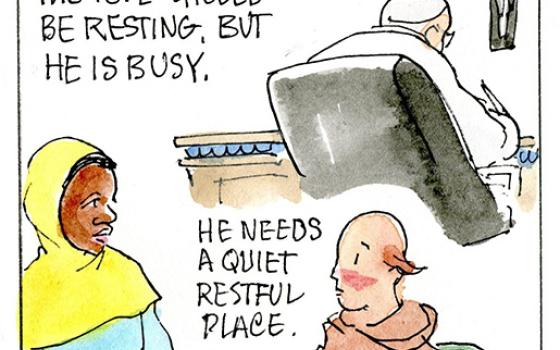Floodwaters cover a road after Hurricane Ian made landfall in Fort Myers, Fla., Sept. 28, 2022. (CNS photo/Marco Bello, Reuters)
It's too early to tell the extent of the damage in the Catholic dioceses of Venice and St. Petersburg in Florida following a direct hit Sept. 28 by Hurricane Ian, one of the most powerful hurricanes the state has seen.
However, organizations such as Catholic Charities USA said they have their response teams in place to deal with the aftermath of the massive Category 4 storm that lashed western and central Florida with winds of more than 155 mph Sept. 28 and 29.
Even in a state used to powerful storms, Ian's destruction managed to shock, leaving mementos of its might in the form of cars battered by winds and water, left floating in flooded city streets next to uprooted trees and parts of roofs torn from buildings in the cities of Fort Myers, Tampa and Punta Gorda.
Dioceses that include those areas closed their churches, schools and other gathering centers. The Diocese of Venice posted a video of the Servant Sisters of the Virgin of Matara Sept. 28 as volunteers helped board up windows at St. Michael Church in Wauchula in the northern part of the diocese.
There were no updates on social media or on the websites of those dioceses early Sept. 29.
Bishop Gregory L. Parkes of St. Petersburg, which includes Tampa, and Bishop Frank J. Dewane of Venice had asked for prayers, knowing their diocesan territories were in the crosshairs of the storm.
Some other U.S. bishops kept an eye on the hurricane and offered solidarity with the people of Florida.
"We pray for all people in Florida, especially for people's lives affected," wrote Archbishop Gustavo García-Siller of San Antonio on Twitter just before the hurricane made landfall. "May you, Lord, be their strength! We do not control everything."
More than 2.5 million were left without electricity as the hurricane, downgraded to a tropical storm early Sept. 29, headed north toward Georgia, North Carolina and South Carolina. Family members desperately posted on Twitter asking for updates on conditions in places such as Venice, close to where the storm made landfall and where many remain without communication.
Authorities began to survey the damage early Sept. 29, looking for those who had not managed to leave before the hurricane hit, but so far no fatalities were reported. They asked those who stayed in their homes to remain indoors as officials were conducting water rescues but still struggling to make their way amid debris and remaining flooding and wind.
Catholic Charities USA said in a statement that its disaster response teams "have a long history of mobilizing quickly to meet the needs of those affected by catastrophic events in the U.S. and its territories."
The organization encouraged donations at https://ccusa.online/Ian for efforts to help those dealing with the storm's destruction.
Florida Gov. Ron DeSantis said Sept. 28 that recovery efforts need financial assistance, and asked people to refrain from sending items, such as clothes, to Florida and send economic help or volunteer instead.
He also said he asked President Joe Biden for a major disaster declaration for the federal government to pay for recovery efforts in the state. The president did so in the morning on Sept. 29.
Hurricane Ian makes its way to Florida's west coast after passing Cuba in a composite image from the National Oceanic and Atmospheric Administration Sept. 27, 2022. (CNS photo/NOAA, Handout via Reuters)
Before striking Florida, Hurricane Ian made landfall Sept. 27 in Cuba's western region of Pinar del Rio, with sustained winds of 125 mph that took down the entire island's electric grid.
The Diocese of Pinar del Rio posted on Facebook photos of hurricane damage to its cathedral and four other churches.
"We are still without electricity and have a bad (internet) connection. The damage has been horrible in both churches and houses. It was a long and intense night and morning. Please pray for us," someone wrote in the Facebook post.
As of midday Sept. 28, Cuban authorities so far had reported two deaths and said some electricity has been restored, mostly in the capital, Havana, but that it would take a while for the island to return to normal.
Telepinar, Pinar del Rio's regional TV station, posted on social media photos of collapsed walls, flooding, trees and debris left in the hurricane's wake.
Pinar del Rio Diocese showed damage to the exterior to its San Rosendo Cathedral, as well as of broken stained-glass windows and other structures at Consolación, La Palma, Viñales and San Cristóbal churches.
Advertisement
Cuban President Miguel Díaz-Canel toured Pinar del Rio, an area known for its tobacco industry, and said it was too early to tell the full extent of the damage, but the governments of Mexico and Venezuela said they would help, and he thanked them for their "solidarity in the most difficult times."
Media website 14ymedio reported that 5,000 "tobacco houses" were damaged and said there was untold destruction of crops in the area.
Major city centers such as Santiago de Cuba, close to the island's iconic Shrine of Our Lady of Charity of El Cobre, remained without power.








